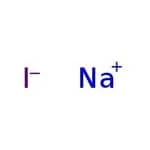Search Thermo Fisher Scientific
Iodure de sodium, 99+ % (pds sec, eau < 1,0 %), Thermo Scientific Chemicals



Iodure de sodium, 99+ % (pds sec, eau < 1,0 %), Thermo Scientific Chemicals
Identifiants chimiques
Spécifications
Description
This Thermo Scientific Chemicals brand product was originally part of the Alfa Aesar product portfolio. Some documentation and label information may refer to the legacy brand. The original Alfa Aesar product / item code or SKU reference has not changed as a part of the brand transition to Thermo Scientific Chemicals.
L‘iodure de sodium est largement utilisé pour l‘échange d‘halogénures (réaction de Finkelstein), par exemple dans la conversion d‘un chlorure d‘alkyle, de chlorure d‘allyle et de chlorure d‘arylméthyle en leurs iodures respectives, qui sont des précurseurs pour les produits pharmaceutiques et chimiques fins. Ils sont utilisés pour déterminer l‘efficacité de la formation d‘adduits de Wittig à partir de chlorures et de bromures moins réactifs. Les préparations appropriées trouvent leur utilisation comme supplément nutritif. L‘iodure de sodium est utilisé comme précurseur de l‘agent de contrôle dans la polymérisation par émulsion ab initio. L‘iodure de sodium est utilisé dans la détermination de l‘oxygène dissous dans la méthode modifiée de Winkler, la synthèse du colorant fluorescent coppersensor-1 (CS1) pour l‘imagerie des bassins de cuivre labile dans des échantillons biologiques et le clivage des esters, des lactones, des carbamates et des éthers en association avec le chlorotriméthylsilane.
Solubilité
Très soluble dans l‘eau et l‘ammoniac liquide. Librement soluble dans l‘acétone, l‘acide formique, le formamide, le méthanol et l‘acétonitrile. Soluble dans le N,N diméthylformamide.
Remarques
Déliquescent. Conserver dans un récipient hermétiquement fermé. Incompatible avec les agents oxydants et les acides minéraux.
Figures
Documentation et téléchargements
Certificats
Foire aux questions (FAQ)
Citations et références
Sécurité et manipulation
Classification of the substance or mixture
CLP classification - Regulation(EC) No 1272/2008
Label Elements
Signal Word
Danger
Hazard Statements
H315 - Causes skin irritation
H319 - Causes serious eye irritation
H372 - Causes damage to organs through prolonged or repeated exposure
H400 - Very toxic to aquatic life
Precautionary Statements
P264 - Wash face, hands and any exposed skin thoroughly after handling
P280 - Wear protective gloves/protective clothing/eye protection/face protection
P302 + P352 - IF ON SKIN: Wash with plenty of soap and water
P305 + P351 + P338 - IF IN EYES: Rinse cautiously with water for several minutes. Remove contact lenses, if present and easy to do. Continue rinsing
P314 - Get medical advice/attention if you feel unwell